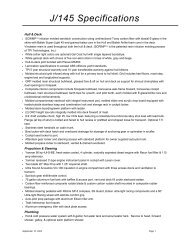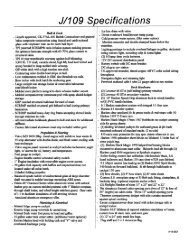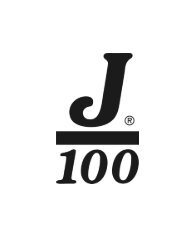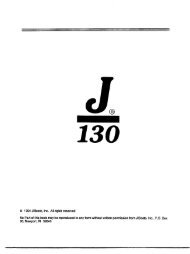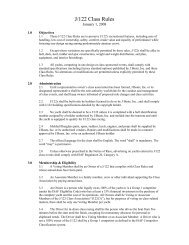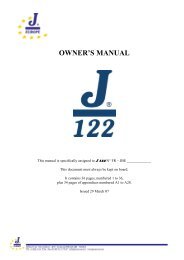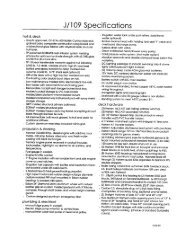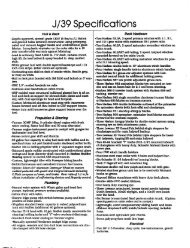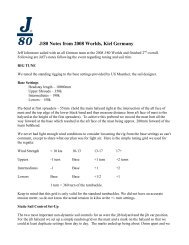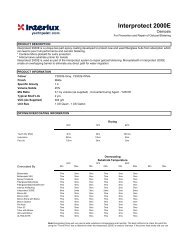WindCheck Template - J/Owners
WindCheck Template - J/Owners
WindCheck Template - J/Owners
Create successful ePaper yourself
Turn your PDF publications into a flip-book with our unique Google optimized e-Paper software.
Class Act<br />
A Look at the J/44<br />
One-Design Class<br />
By Chris Szepessy<br />
The J/44 is the most successful large offshore American yacht<br />
design ever. Until 2006, it was the only boat to have a one-design<br />
start in the Newport to Bermuda Race, and anyone who’s watched<br />
the action at Block Island Race Week, the American Yacht Club<br />
Spring & Fall Series or the Manhasset Bay Fall Series has seen J/44<br />
sailors enjoying some of the tightest class racing around.<br />
The J/44 came about as a result of a study of the 1988 Newport-to-Bermuda<br />
Race by the J/Boats management and design<br />
team. The company was thinking of building something bigger<br />
than the J/40 and their analysis determined that the most popular<br />
offshore boats were racer/cruisers between 41 and 45 feet. Designed<br />
by Rod Johnstone and built by TPI, the J/44 was launched<br />
in May 1989 and Sailing World Magazine named it Boat of the<br />
Year in 1990.<br />
Sixty-eight ‘44s’ were built, and they’re sailed by enthusiastic<br />
owners in 14 countries. The 44 was victorious in the Fastnet Race<br />
(IMS Overall; 1991), the Sydney-to-Hobart Race (IMS-1; 1992)<br />
and the Bermuda Race, and it’s a fine cruising boat that can be<br />
comfortably handled by a couple. Many sailors consider the 44 to<br />
be “the perfect boat,” but it takes more than a boat to make a<br />
great class. We asked Tom Castiglione, the J/44 Class Director<br />
and Jim Bishop, Class President and co-founder, about their winning<br />
formula.<br />
Bishop, who owns Gold Digger (USA 49; New York, NY),<br />
the J/44 North American Champion in 1995, ’99, 2000 and ’02,<br />
explained that the template for the J/44 One-Design class rules<br />
was implemented by the International One Design class in the<br />
1960s. “A number of International owners were quite well-heeled,<br />
while others weren’t,” he said. “Some boats were being pulled out<br />
every Monday, being fiddled with and having their bottoms done,<br />
and they’d come back with new sails. These fellows decided to<br />
stop fooling around, so they created a rule where you could only<br />
haul a boat twice a season, and they went with one-design sails.<br />
That created an extremely level playing field…the International<br />
class produced every skipper for every 12-Metre in the America’s<br />
Cup Trials until Bill Ficker came from the West Coast.” The J/44<br />
One-Design Class Association was established in 1994, and it’s attracted<br />
good sailors from a wide financial spectrum. “We have<br />
people who have sailed all their life in one-designs, so it’s a way of<br />
moving the one-design sailing experience into ocean racing without<br />
having to be somebody who’s spent most of their life accumulating<br />
capital,” said Bishop.<br />
The J/44 Class owns and maintains 16 sets of class sails. “We<br />
only have three one-design sails: a #1, a main and a 3/4-ounce<br />
spinnaker,” Bishop continued. “We rotate them and keep track of<br />
the hours on each sail.” Castiglione, a sail consultant at North<br />
Sails, explained, “Members pay one-design fees that maintain<br />
these sails, so for $3,500 a year (for the sail program), you can<br />
campaign a 44-foot boat at a pretty high level. If someone’s going<br />
to campaign a 44-footer without this structured one-design sail<br />
program, they could spend upwards of $30,000 a year on sails,<br />
and that’s just replacing a few to remain competitive in a class.”<br />
“Before we race, we have a person designated to call what sail<br />
we’re going to use,” Bishop said. “If it’s blowing harder, we go<br />
with our own #3 and 1 1/2 -ounce spinnaker. This keeps people<br />
from blowing out their sails. We’ve gotten six years out of a mainsail<br />
and I think we got six years out of a jib, and not one person<br />
has ever complained that they lost a race because of the sails.”<br />
windchecklis.com <strong>WindCheck</strong> December 2007 49
A Sprit for the J/44<br />
By Scott Dinhofer<br />
In an effort to breathe new life into our J/44 Brown-eyed Girl<br />
(USA 44007) we embarked this year on installing a bowsprit and<br />
asymmetrical sails. Bill Ketcham, the owner of J/44 Maxine (USA<br />
83000) and I worked on this together. The requirements were<br />
simple deployment, cost effectiveness and robust engineering. I<br />
worked on the feasibility study with Alan Johnstone of J/Boats.<br />
The starting point was essentially a J/133-sized spinnaker. After<br />
consulting with numerous sailmakers and running a few trial IRC<br />
certificates, we came up with a sprit and spinnaker size that we<br />
felt was optimal.<br />
We achieved a spinnaker with 30 percent greater area and an<br />
equally longer luff - with no penalty under IRC. Of course, this<br />
means that we can no longer pole back. We feel that if we were to<br />
use this in distance races or achieved a one-design class conversion,<br />
it wouldn’t be a factor. It’s our belief that we’d gain on the standard<br />
rig in light, pole-on-the-headstay reaching conditions, and begin<br />
to lose out somewhere in the mid-teens, as traditional boats would<br />
be able to pole back. We also believe we’ll gain ability to handle<br />
the boat in true heavy air conditions without wiping out.<br />
The execution of the sprit design by Goetz Custom Boats of<br />
Bristol, RI was flawless. They engineered a forward ring on a<br />
bracket that’s through-bolted to the stem fitting on the bow. The<br />
robust carbon pole sits in this collar with the butt end affixed to<br />
two pad eyes on deck. The sprit has both a rear unloaded storage<br />
position and a forward deployed position tied into the boat structurally<br />
via an under-deck L-bracket bolted to the forward bulkhead.<br />
We’ve had three opportunities to test this configuration to<br />
date: the Vineyard Race, the Stamford-Denmark Friendship Race<br />
and the Indian Harbor Yacht Club Gearbuster. We started the<br />
Vineyard Race with a code zero flying from the end of the pole.<br />
We saw a fair amount of lateral flex in the pole and slight upward<br />
flex. We think this was about the heaviest loads we would see, as<br />
it was tight for a code zero and was blowing around 17.<br />
Given the nature of this year’s Vineyard Race, we ended up<br />
flying various genoas and our jib top more than anything. We utilized<br />
the sprit again for the code zero between the tower and<br />
Block Island. I’d like to think this was our “secret weapon,” as we<br />
won our class! The only issue we had was the bow piece bent<br />
quite a bit and we sent it back to GMT Composites in Bristol for<br />
reengineering. The folks at GMT, led by David Schwartz, were<br />
very helpful and stood by their work. We’ve since bolted a much<br />
heavier piece to the bow and haven’t seen those issues since.<br />
We sailed against two other J/44s in the Friendship Race,<br />
and beat them by a bit on the first three-mile windward leg, so we<br />
didn’t see a side-by-side comparison with the symmetrical spinnaker.<br />
We flew our largest sail, the 2A runner, on the first downwind<br />
where it got extremely light and were able to keep the sail<br />
full and drawing the entire time.<br />
photoboat.com<br />
After a fetch and a strong southerly filling in, we rounded<br />
Bell 14 off Lloyd’s Point about six boatlengths behind Steve Benjamin’s<br />
High Noon. Our sail chart had us on the edge between the<br />
3A reaching spinnaker and the code zero. We opted for the 3A so<br />
we could start to learn our angles. It turned out to be the right<br />
call. We gained on High Noon in a 14-knot southerly, finishing<br />
overlapped with them. We won our class in this race, a first for<br />
the Brown-eyed Girl team!<br />
The Gearbuster started in a light but building westerly (255-<br />
265) and our course was 94 to the Stratford Shoal tower. This<br />
would be a good test in a run. Our competition was a number of<br />
well-sailed boats: a J/122, J/133, J/37 and Bombardino, a Santa<br />
Cruz 52. The wind built, and most of this 22-mile run was sailed<br />
in 12-14 knots - conditions where we thought we’d lose out to a<br />
symmetrical boat on rating.<br />
We sailed the shifts and pressure lanes, jibing about eight<br />
times, and we lost the J/122 on a shift or missed pressure. We<br />
pressed down and appeared to hold our time on Bombardino and<br />
the J/133. We later learned that our North Sails designer, aboard<br />
the J/122, felt we’d consistently sailed at too high an angle, but<br />
given that we finished second we feel good about the boat’s ability<br />
to sail with the new kites. ✦<br />
Scott Dinhofer lives in Chappaqua, NY. Racing under the burgees of<br />
Indian Harbor Yacht Club and the New York Yacht Club, Browneyed<br />
Girl (USA 44007) was the first IMS finisher in the 2001<br />
Around Long Island Regatta, and won the J/44 class in the 2006<br />
Newport-to-Bermuda Race. “In the 18 years since the first J/44 was<br />
built, nothing has come along to unseat it in this size range as an offshore<br />
racer that can truly be cruised comfortably and raced around<br />
the buoys,”says Dinhohofer. The team’s online at: usa44007.com.<br />
50 December 2007 <strong>WindCheck</strong> windchecklis.com
“The unique thing about this class is that they’re not building<br />
any more of these boats. The owners have a lot more control,<br />
and that helps the class,” said Castiglione. “This formula can be<br />
done in other classes if the owners will take control of the class,<br />
and it should be done, because it keeps people in sailing,” said<br />
Bishop, who will be competing in his twentieth Bermuda Race<br />
next June. “I’ve been ocean racing since 1960, and most of the<br />
people I sailed with got out of sailing. One guy - who built four<br />
ocean racers - got out because a boat would be obsolete by the<br />
time it was launched. It’s not good for sailing to have people run<br />
through a class because they’re told they’ll win if they spend<br />
enough, because there’s always somebody with more money.”<br />
“Every owner gets a vote when we change something, and<br />
we’ve made changes to keep the boat up-to-date and going fast,”<br />
Castiglione continued. “When I first got involved, the spinnaker<br />
poles were all aluminum, and after a good bit of discussion the<br />
owners decided it was an upgrade to get carbon poles, which are<br />
lighter, faster and safer…same thing with the winches and mainsheet<br />
system. That’s why we experiment with things like sprits,<br />
different size poles and spinnakers. For example, the boat gets a<br />
credit under IRC for a smaller headsail.” Bishop added, “We’ve<br />
found that with a little bit of breeze, a 145 is faster than a 155.<br />
The boat has a big, big main, and the smaller jib reduces backwinding.”<br />
“The guys who’ve tried the sprit like it,” said Castiglione (see<br />
left). “The initial concept was to make the boat easier to sail with<br />
fewer people. Sprits have proven very effective on distance races,<br />
but if you’re sailing a distance race, you want to maximize IRC<br />
crew weight, keep the rail down and keep the boat going as fast as<br />
possible.” Bishop added, “There’s no question that the asymmetrical<br />
is faster on a close reach, but on the short windward-leeward<br />
courses that we sail almost all the time, it isn’t. Then you have to<br />
fool around with jibing those things. I don’t think it’s the answer,<br />
but it’s interesting to try these things.”<br />
“Two years ago, we wrote into the rules that an additional<br />
The J/44 dock party in Bermuda has become one of the post-race highlights.<br />
crewmember under the age of twelve will be allowed on the boat<br />
at any time for any event, regardless of the number of crew on<br />
board,” said Castiglione. “That’s specifically to get kids used to<br />
sailing on a big boat. There’s been quite a handful of young kids<br />
out there doing it – it’s been great.”<br />
“There’s a pretty good contingent of family members on<br />
every boat,” Castiglione continued. “Most of Larry Glenn’s crew<br />
on Runaway (USA 444; Oyster Bay, NY) is his family. His wife<br />
Anne is the tactician more often than not. Resolute (USA 43787;<br />
Huntington, NY) owned by Don & Rick Rave, is the newest<br />
boat in the class. Don’s son is their tactician and his father sails<br />
with him often, too.” Resolute placed 2nd in the 2007 J/44 season<br />
rankings. Bishop’s son Jim Jr. is Gold Digger’s tactician.<br />
Jeff Willis (Challenge IV USA 42880; Huntington, NY),<br />
who sails with his sons David, Tim and Todd, finished first in<br />
class in the 1994 Bermuda Race. Challenge IV has won the J/44<br />
North Americans every year since 2003, and she won her class at<br />
this year’s Block Island Race Week, the American YC Fall Regatta<br />
and the Manhasset Bay Fall Series. “It’s been great having the<br />
Coast Guard Academy sailing a 44 (Glory USA 42324; New London,<br />
CT),” Castiglione said. “There’s nothing better for training<br />
than getting young sailors on boats and teaching them offshore<br />
sailing.” Glory, skippered by Robert Lally, won the IRC II division<br />
in the 2007 Annapolis to Newport Race. Seven J/44 owners<br />
loaned their boats to college teams for the 2007 Storm Trysail<br />
Club Intercollegiate Offshore Regatta. The U.S. Naval Academy<br />
sailed Resolute to victory in the 44 division with a perfect score.<br />
“When we go into the final race of a series, any one of about<br />
five boats can win on the last day,” Bishop said. “We had thirteen<br />
boats in the Bermuda Race one year, and ten of them finished<br />
within an hour and a half. If you race together for a period of time<br />
as we have, and the boats are as even as they are, it creates a<br />
charisma among the participants.” Castiglione added, “The onedesign<br />
class has made the boat, the crews and the racing as good as<br />
they are, and I can safely say that the J/44 party is one of the best<br />
parties in Bermuda that week. It’s grown<br />
from a couple hundred people to where<br />
we’ve sunk docks the last two years. I don’t<br />
know how we get that much rum down<br />
there, but it’s turned into quite the event.”<br />
There are seven or eight 44s currently<br />
for sale – all in essentially race-ready<br />
condition, according to Bishop and Castiglione,<br />
who noted, “If someone wants a<br />
boat we’ll help them find one.” Bishop<br />
added, “The boats are selling for about<br />
$230,000 to $250,000, and it’s really a<br />
dual-purpose boat. A new boat like that<br />
would cost about a million dollars. We’re<br />
looking forward to having more people understand<br />
what we’ve got going, because I<br />
think it’s quite special.” For more information,<br />
visit the J/44 One-Design Class Association<br />
website at j44.org. ✦<br />
windchecklis.com <strong>WindCheck</strong> December 2007 51



